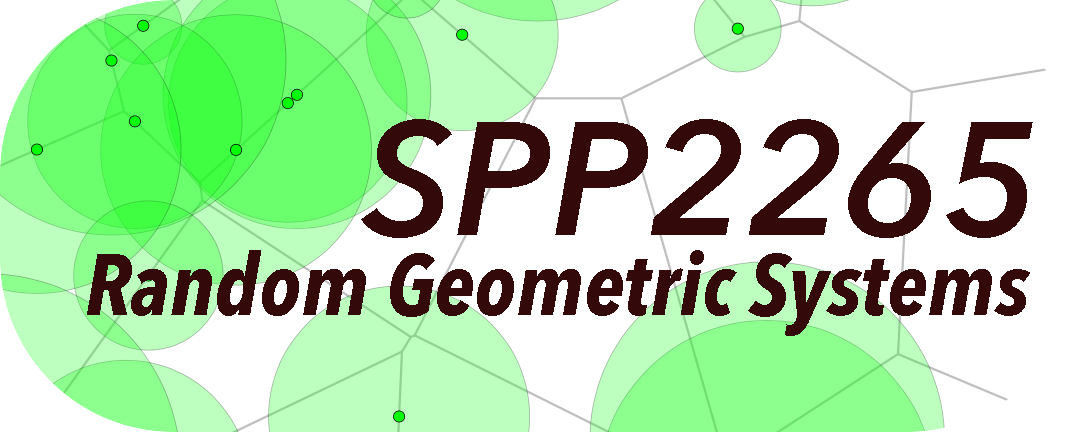x
Abstracts
Markus Heydenreich (LMU Munich)
The weight-dependent random connection model
We investigate a large class of random graphs on the points of a Poisson process, which combine scale-free degree distributions and long-range effects. Every Poisson point carries an independent random weight and given weight and position of the points we form an edge between two points independently with a probability depending on the two weights and the distance of the points. This generalises many spatial random graph models.
Our focus is on the question whether infinite components are recurrent or transient, and we demonstrate that the answer depends on the model parameters.
In a plain version of the random connection model, where weights are ignored, we can even analyse the model at the phase transition point. Indeed, we obtain an infrared bound for the critical connectivity function if the dimension is sufficiently large or if the pair connection function has sufficiently slow decay. This is achieved through an adaptation of the percolation lace expansion for Poisson processes.
Based on joint work with Peter Gracar, Remco van der Hofstad, Günter Last, Kilian Matzke, Christian Mönch, and Peter Mörters.
Mia Deijfen (Stockholm University)
Weighted graphs and epidemics
I will discuss a random graph model with prescribed degree distribution and degree dependent weights on the edges. An expression for the threshold for the appearance of a giant component in the graph is derived, and the same technique also gives an expression for the basic reproduction number for an epidemic on the graph, where the probability that a certain edge is used for transmission is a function of the edge weight. It is demonstrated that, if vertices with large degree tend to have large (small) weights on the edges and if the transmission probability increases with the edge weight, then it is easier (harder) for the epidemic to take off compared to a randomized epidemic with the same degree and weight distribution. The model is also fitted to three empirical weighted networks of importance for the spread of contagious diseases and it is shown that R_0 can be substantially over- or underestimated if the correlation between degree and weight is not taken into accout.
András Tóbiás (TU Berlin)
SINR percolation and k-nearest neighbour graphs
SINR percolation is an infinite-range dependent variant of continuum percolation, which is used for modelling connectivity in telecommunication networks. The users of the network form a stationary point process in R^d, and a transmission between two users is successful if and only if measured at the receiver, the signal of the transmitter is large enough compared to the interference coming from all the other users plus some external noise. The SINR graph is defined via connecting two points of the point process by an edge whenever the transmissions between them are successful in both directions. We are interested in the question whether this graph percolates, i.e., whether it has an infinite connected component. This model was introduced by Dousse, Baccelli, and Thiran (2005), who studied the case of a two-dimensional Poisson point process with a fixed submitted signal power. In this talk, we investigate the case when the users form a stationary Cox point process in R^d, d>1, while signal powers are random and possibly unbounded. We provide sufficient conditions for the occurrence of percolation in the SINR graph in case the spatial intensity of users is strong enough and interferences are sufficiently reduced (without vanishing). Relevant examples of Cox point processes include Poisson point processes on random street systems given e.g. by Poisson--Voronoi or Poisson--Delaunay tessellations.
Another characteristic feature of SINR graphs is that their degrees are bounded, which was observed by Dousse et al. We show that for all relevant stationary Cox point processes, there is no percolation in case degrees are bounded by 2, regardless of the spatial intensity. This degree bound also implies that in case signal powers are constant, the SINR graph is a subgraph of the bidirectional k-nearest neighbour graph introduced by Balister and Bollobás (2008), where k is the degree bound. Our proof techniques of non-percolation extend to the bidirectional 2-nearest neighbour graph. This in turn partially verifies the high-confidence result of Balister and Bollobás that the bidirectional k-nearest neighbour graph of a stationary Poisson point process in R^2 does not percolate for k<5. The subject of this talk is joint work with Benedikt Jahnel.
Nataša Djurdjevac-Conrad (Zuse Institut Berlin)
On spatio-temporal models for spreading processes
Modeling of spreading processes has gained a lot of attention in the last decades, since these processes play a crucial role in understanding a wide range of real-world systems that span biological, technical, economic and social sciences. In this talk, I will present stochastic models for spatio-temporal dynamics of interacting agents (particles). First, we will study stochastic agent-based models, where the mobility of agents is defined by position dynamics and spreading is governed by interaction dynamics. Two agents that are close to each other form an interaction edge and possibly adopt the status of other agents in their neighborhood. We will study dynamics ON and OF this time-evolving interaction network. Next, based on dynamical properties of this system on a micro-scale, we will derive a reduced model on a meso-scale. Finally, we will compare the two models on real-world examples.
Günter Last (KIT Karlsruher)
On hyperuniformity and rigidity of point processes
A point process in Euclidean space is said to be hyperuniform,
if the variance of the number of points in a large ball grows significantly
more slowly than its volume. It turns out that this
property is closely related to number rigidity. The latter property
means that the number of points inside a given compact set is almost
surely determined by the configuration of points outside.
Rigidity and hyperuniformity are properties that unify crystals and
exceptional random systems.
The local behavior of processes with those properties
can very much resemble that of a weakly correlated point process.
Only on a global scale a regular geometric pattern might become visible.
We will start the talk with providing some examples
and discussing a few fundamental properties of hyperuniform
point processes. Then we shall present
a new class of hyperuniform point processes introduced and studied
in recent joint work with M. Klatt (Princeton) and D. Yogeshwaran (Bangalore).
It arises by a peculiar thinning of a stationary Poisson process
(or a more general determinantal point process) based on a stable
matching procedure. This thinning
is also number rigid. We finish the talk by giving an example of
a hyperfluctuating (the counterpart of hyperuniform) mixing point process
which is still rigid in the strongest possible sense.
This example is taken from a recent joint paper with M. Klatt and disproves
the previous belief, that mixing and strongly rigid point processes
are hyperuniform.
Elie Cali (Orange Paris)
Some applications of stochastic geometry in Orange Labs
For several years, Orange Labs have been developing models for road systems using stochastic geometry and more especially planar random tessellations. We use these models to study the deployment of fixed network on urban or rural territories, and to study multi-hop device to device connectivity in wireless networks. I will give some examples of our using those models to derive cost elements and other values of interest to Orange.
Julia Komjathy (TU Eindhoven)
Shape of epidemic curves in spatial scale free networks
I will present recent results on degree dependent first passage percolation, on spatial networks where degrees are following some power-law and long-range edges are also present. Geometric Inhomogeneus Random graph, Hyperbolic Random Graphs, and Scale free percolation fall into this model class.
For the first passage percolation, we allow the transmission times across edges to depend on the degrees involved.
We characterise the possible growth rates of the number of sites occupied by time t, aka the epidemic curve.
Joint work with John Lapinskas, Johannes Lengler, and Ulysse Shaller.

